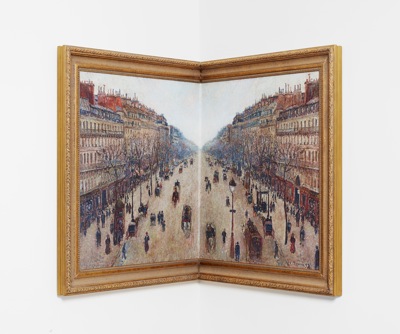
‘There’s nothing serious enough to take seriously’, Marcel Duchamp
Everyone knows that 2014 is the centenary of Gabriel Princip blowing the whistle for the start of WW1, but it is also the centenary of Duchamp’s first exhibition of a ready-made artwork. He may have created Bicycle Wheel in 1913 but he didn’t show it until later – the first ready-made he exhibited was Bottle Rack in 1914.
Duchamp’s work was the biggest game-changer in art history since the invention of the eraser and has influenced countless artists. To celebrate the anniversary curator Kate Bryan at the Fine Art Society has asked over fifty contemporary artists what they have learned from Duchamp. Being artists they haven’t just sent her an email back, they’ve replied with a piece of art work. The entire five-floor building on Old Bond Street has been given over to the show What Marcel Duchamp taught me? which combines pieces with wit, playfulness and ambiguity, just as Duchamp would have liked.
This is a large scale exhibition, with pieces from artists around the world. It includes four new site-specific installations, as well as video, photography and performance pieces. There are even sculptures and paintings. Artists include big names such as Peter Blake, Martin Creed, Cornelia Parker and David Shrigley. There is also a Man Ray photograph of Marcel Duchamp as his feminine alter ego Rose Sélavy and one of the bonds that Duchamp himself issued to raise funds when planning to break the bank at Monte Carlo.

James Thurgood
‘Beautiful Image #8’ 2013
Courtesy the artist and The Fine Art Society
Duchamp derided the adoration of art and any sense of taste. He said once, “I force myself to contradict myself so as to avoid conforming to my own taste”. His works were not supposed to be beautiful, a fact taken to heart by James Thurgood. If any of his photographs are called beautiful by a viewer he reserves them for destruction. It is though a unique form of destruction – he enlarges them and coats them with gold leaf. The image may be gone, but something far more valuable has been created. The viewer is always involved in finishing a work of art. Here it becomes explicit.

Nancy Fouts
‘Corner Painting Camille Pissarro’ 2012
Courtesy the artist and The Fine Art Society
Nancy Fouts has created a witty piece called Corner Painting which subverts a Camille Pissarro image. Bending it at right angles so that the framed picture fits perfectly in a corner it seems to mock collectors who buy pictures for particular spaces. If only it could have been created with a real impressionist canvas – surely there’s a collector with deep pockets and a sense of humour who could have been involved.
The works go on and on, some covering whole walls, some looking like art, others indistinct and sly – like Susan Collis’ left over screws and staples that didn’t need to have been made of gold and platinum and Ceal Floyer’s garbage bag, which hasn’t been recast in bronze or gold but is what it is, a black bin bag. Duchamp would have liked it to be filled with garbage, rotting as the show went on, but it’s actually London air, referencing Duchamps’ own phial of Air de Paris.
Some pieces do reference Duchamp’s works directly, with chess pieces and chess boards, glass sheets and shards. There is a bottle rack, though I didn’t notice a urinal. But most artists take inspiration from his iconoclasm and sheer chutzpah. One hundred years ago Duchamp first took a pre-existing object and declared it to be art. The shock was huge and this show cannot recreate that reaction, but it demonstrates that Duchamp’s legacy continues to be felt by contemporary artists today.
Until 5th November

Leave a Reply